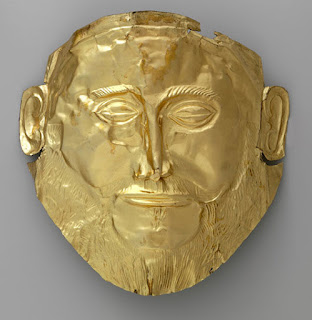ELECTRA: Everything dies – the dust is forgotten.
How can we hope to do what has to be done? (Hughes, 109)
Robert Fagles calls it The Libation Bearers; Ted Hughes
prefers Choephori; in either case it’s the play where the bloodthirsty
chorus of female slaves howls for avenging the murder of Agamemnon that we all
enjoyed so much in the previous play.
CHORUS: Let me scream
That holy scream of joy.
Why should I smother it?
If Justice shares my hope,
If God rides the savage storm
That shakes my heart for vengeance –
Vengeance, vengeance, vengeance. (Hughes, 111)
Will we enjoy the murder of Clytemnestra as much?
I would have guessed that this chorus, captives taken by
Agamemnon over the course of the Trojan War, would not be so firmly on his
side, but he is dead and his murderers and their current enslavers, Clytemnestra
and Aegisthus, are alive. The chorus, as
we have often seen in Aeschylus, gets a lot of good lines.
The Libation Bearers is tragedy mixed with fairy tale,
with its cute brother and sister recognition scene, where Electra recognizes
the presence of her brother by the shape of his footprint in the dust –
remember this when we get to Euripides – and a parallel pair of curious
anti-recognition scenes in the second half of the play, when first the Orestes’s
mother and then his nurse fail to recognize him. The nurse’s failure is admittedly a little more
conceptual and thematic, part of the nursing theme that is itself part of the
larger washing theme, corrupting blood countered by cleansing water and
milk. Agamemnon was all blood.
Not that The Libation Bearers does not have plenty of
blood.
CHORUS: But Orestes fought, he reached the summit
of bloodshed here… (Fagles, 219)
This is more or less at the moment when Orestes kills his
mother, egged on by the chorus and his best friend. My understanding of the ethics of the play is
that the killing of Aegisthus, the uncle of Orestes and an usurping tyrant, is
at worst neutral, just power politics, while the killing of his mother is an abomination,
one more in a long line for this family.
The most curious moment to me was just before the lines above, when
Orestes hesitates and doubts:
ORESTES: Pylades, can a man kill his mother?
Can he perform anything more dreadful
Than the murder of his own mother?
What shall I do?
PYLADES: Remember the words of Apollo.
Obey the command of the god of the oracle.
Embrace the enmity of mankind
Rather than be false to the word of heaven. (Hughes, 134-5)
The strange thing is that these are the only lines of
Pylades, who has otherwise been silently shadowing Orestes through the play. If I think like a fantasy writer, then this
creature is clearly some kind of double, Apollo, or an agent of Apollo (or of someone
else?} who has taken the form of, or possessed, the friend of Orestes. Just a few pages later, we see that “Pylades”
is essentially lying: it is the Furies, not men, who begin to torment Orestes.
They are climbing out of the earth,
Out of their burrows in old blood.
Eyes like weeping ulcers,
Mouths like fetid wounds.
Their whips whistle and crack. (Hughes, 144)
In an earlier speech (Hughes, 106), Orestes says this is what
Apollo told him would happen if he did not avenge his father. Apollo is a liar.
CHORUS: Where will it end? –
where will it sink to sleep and rest,
this murderous hate, this Fury? (226, tr. Fagles)
And curtain, although the Greeks did not have curtains. An
intermission, a week long for us, and then we will get the answers to those
question in The Eumenides, or The Kindly Ones, where we will say
farewell to Aeschylus.
One more curious thing is that we will return to this story
three more times, in Sophocles and Euripides.
So few of the plays survive, but we have four versions of this story.
The painting is Louis Jean Desprez’s “The Tomb of Agamemnon,”
a study for an 18th century Swedish opera, a surprising item owned by the Metropolitan Museum of Art. One more
Aeschylus play with an altar in the center of the stage.






